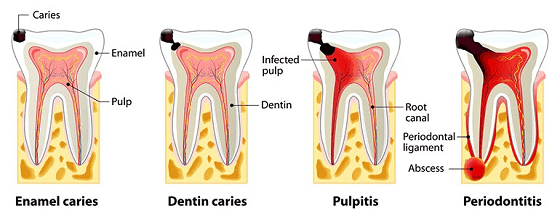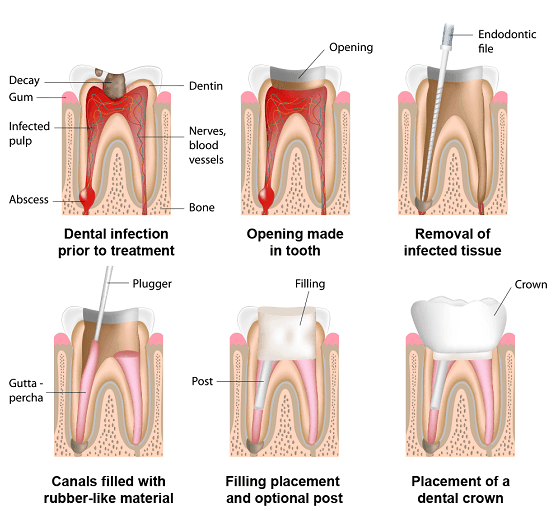One of the primary reasons people are forced to visit their dentist is due to tooth discomfort or worse, toothache. However, it is often difficult to determine when a toothache can be resolved by a simple filling or when is a root canal needed.
A brief about your tooth structure
Much against contrary belief, dentists are nice people. They help resolve your tooth issues especially when your tooth suddenly starts paining. But, what in your tooth is essentially giving rise to this pain? To determine this, let’s briefly understand the structure of a tooth.
No matter the four different types of teeth that we have in our mouth, the basic structure of all the teeth remains the same. Each tooth has an outer white, hard substance called the enamel, the second layer lying below the enamel called dentine and the inner-most layer called pulp. It is this pulp layer which keeps your tooth alive as it contains blood vessels and nerves.
The next time the thought of “When is a root canal needed?” crosses your mind, blame it on the pulp! Well, kind of, as it is this pulpal layer which gets infected and the nerves in it cause pain which we perceive as toothache.
When the words ‘root canal’ are said, most people think of the treatment procedure but in reality, it is this innermost layer of the tooth that is being referred to. When your dentist or endodontist(the specialists who perform root canal treatments) advises a root canal procedure, it means that they are going to remove the infected pulp of the decayed tooth, clean the canal fill it with an inert material and seal your tooth.
So, to answer the basic question of “When is a root canal needed?” that most patients have, the answer is – when your root canal gets infected!
How does your tooth and the root canal get infected?
So, what causes a root canal to get infected? Well, the most obvious reason is tooth decay reaches and penetrates the pulp, resulting in root canal infection. Here are some common causes of root canal infections:
- Decay that begins in the upper layers of the tooth and eventually reaches the pulp
- A tooth that has a crack, is broken or a major portion is chipped-off creates a portal of entry for bacteria into the tooth.
- Tooth injuries
- Abnormalities in the tooth shape that predispose it to tooth decay
- Infections of the gum that affect the root canal from within the gum
- Sudden death of the pulp tissue due to a blow or sudden impact to the tooth
- Recurring decay and subsequent fillings on a tooth
- Repeated root canal treatments on the same tooth

When is a root canal needed?
While there are many reasons for “why a root canal is needed”, but what about the lingering question “when is a root canal needed?”
When pain strikes, it is often difficult to put your mind to your routine work and you are constantly thinking about “are these root canal pain symptoms”, “are these signs of root canal treatment?”, “how do I know I need a root canal?” etc. However, this is what your dentist or endodontist will determine.
To determine when a filling is required and when a root canal is needed, a qualified dentist checks all signs and symptoms of the patient. Some symptoms that patients are likely to experience and that also help the dentist evaluate and diagnose the case better are:
- Pain – A pulsating kind of pain that increases on changing posture, mainly while lying down or at night causing excessive pain at night. The tooth is extremely sensitive and painful to touch, tapping, and biting forces.
- Swelling in the gums and surrounding tissue- In most cases, patients visit their dentists when their tooth ache is probably a few days or weeks old and they haven’t been able to reduce it using painkillers.
This is one of the biggest mistakes that patients can make! Due to this delay, the infection originating in the root canal of the tooth becomes chronic and gives signs to show the urgency that a root canal treatment is required.
The swelling can be tender and painful or completely asymptomatic; it may also come and go. In a large number of cases, the swelling has an opening that allows the pus inside the infected tooth and the surrounding soft tissues to drain by itself.
- Discolouration of the tooth – Many a time, the patients can notice the change in the colour of the infected tooth. This colour change indicates that the tooth pulp is dead and the tooth needs a root canal treatment. Sometimes, the tooth discolouration is evident but the patient is asymptomatic.
- Feeling Ill- Did you know that an infected root canal can cause you to feel ill? It’s true! Many patients have feelings of general illness and even fever, at times.
While these root canal symptoms and signs are identifiable by both patients as well as dentists, there are some signs that only dentists are able to identify and answer the patients’ question -“When is a root canal needed?”
How is a diagnosis made?
To determine when is a root canal required in a patient, dentists use the following methods:
- X-rays- These are inevitable in diagnosing tooth decay, especially to determine when is a root canal needed
- Thermal and electric testing on the tooth to determine if it is alive or dead
- Tapping and percussing the tooth to evaluate the patient’s symptoms
- Checking for obvious nerve exposure while removing decay on the tooth surface
- Cavity test
- Mobility of the tooth
- Chipping or cracked tooth
Are Root canal treatments painful?

Now that you have got a brief idea about when is a root canal required, and learning about the various symptoms that demand a root canal treatment, the next question that creates waves of anxiety in a patient’s mind is “Are root canals painful?”
Thanks to modern technology, equipment and pain control methods, root canal treatments are a breeze for both the patient as well as the dentist. Once your dentist anaesthetizes your tooth and the surrounding area, the pain experienced by you reduces and your tooth and the surrounding area start to get numb.
Once the tooth is numbed, patients are automatically put at ease while the dentist or endodontist carries out the procedure. A root canal treatment takes slightly longer and may require more sittings than a filling. After the infected root canal is cleaned and sterilised, your dentist fills an inert material into the canals and seals them.
Your tooth is now painless and requires a cap to support it.
How to steer clear of root canal problems?
Once a patient has undergone a root canal treatment, he/she is often wary about getting another one done. They now know when is a root canal required and the signs and symptoms you need a root canal. So, the most common query they now have is – how can we prevent root canal problems? Here are some tips that one can follow to prevent dental decay and cavities from arising:
- Floss between your teeth – This is probably more important than brushing your teeth because most dental decay and cavities that result in root canals arise from food that is stuck between teeth and is difficult to clean with plain brushing.
- Brushing your teeth at least twice a day or after every meal
- Use fluoride toothpastes
- Visit your dentist every 6 months for a routine check-up, even when you have no tooth troubles.
- Get cleaning and polishing done twice a year by your dentist.
At Sabka Dentist clinics, our team of dentists provides routine consultations and checks patients for signs of early tooth decay. One common question our doctors are asked at our clinics is “how do I know it is a root canal or a filling?”. Well, when the decay is small or in its initial stages, a simple filling is done. But, when the decay has extended into the pulp and infected it, a root canal treatment is performed.
If you still have queries about when is a root canal procedure performed, feel free to visit one of our clinics and get consulted by our team of dental experts!
Expert’s Opinions
- Dr Reena Waghela Dental Director of Sabka Dentist says “In case of toothache, swelling in your gums, or discolouration of any tooth, visit your dentist at the earliest.”
- Dr Ankita Gada Dental Director of Sabka Dentist says “Following a strict dental hygiene routine with brushing and flossing every day can help prevent tooth decay and painful root canal infections.”





